Breed of chickens Legbar - "super" egg-laying hens
Recently, Legbar chickens are gaining more and more recognition from farmers and owners of private households. They have a lot of advantages and practically no negative sides, and their content does not cause much trouble.

Content
Where did the Legbars come from or the origin
In the company of traditional breeds of laying hens, Legbars appeared not so long ago - by the middle of the last century. Breeders Michael Pease and Reginald Pannett bred them in England.

I had a chance to try several options before getting birds with the desired characteristics. At first, striped Plymouth Rocks and “golden” Kempino cockerels were used. However, the result did not suit the scientists, and they somewhat changed the "foundation": Plymouthrogs and partridge Leghorns participated in the following attempts, and their offspring were crossed with white Leghorn and Araucan.
So, what was needed appeared: universal chickens of the Legbar breed with high egg production and tasty meat, attractive in appearance and viable.

Interesting! The ability to lay many eggs every year is not the only quality that has made the Legbar breed a favorite of poultry breeders. Their testicles are also very beautiful: round, with a bluish tinge of the shell.

What Legbars look like
The description of the Legbar chicken breed deserves special attention. After all, they stand out among the rest of the chicken tribe with an elegant, even dandy appearance.
They are gracefully folded, shining gray with a silvery tint or cream, shimmering gold, plumage, with pronounced stripes in the rooster and more oiled in chickens.
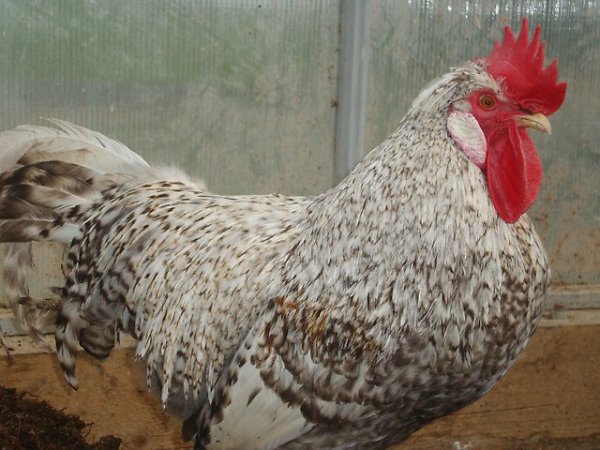
The head of the "young lady" is decorated with a fluffy variegated forelock, and the "cavalier" is crowned with a luxurious raspberry comb. Both males and females boast light-colored catkins and soft, silky feathers.
For a more detailed understanding of the description of the amazing Legbar chickens, it is worth looking at their photos:
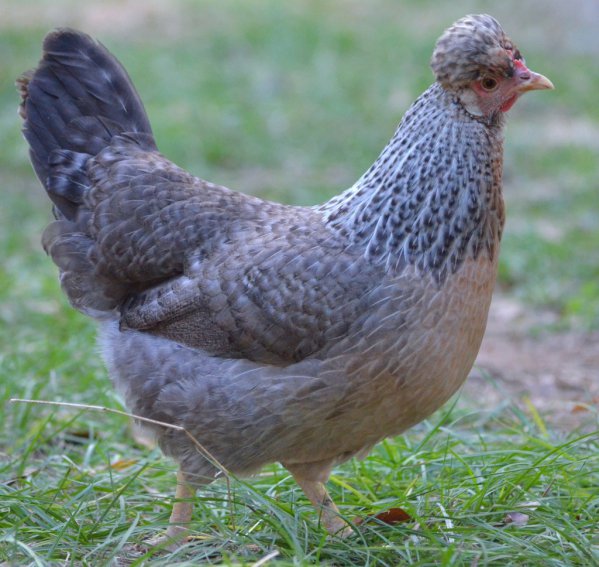

In addition to the above description, in Legbar chickensthere are a few more signs:
- Medium size. An adult rooster can weigh 3-3.5 half kg, a chicken - 2.5-2.8 kg.
- Small head, shiny bright orange eyes, wedge-shaped body, flat long back, wide chest, tightly pressed wings. The legs are thin, but strong, yellow, with four toes.
- Description of the Lehbar roosters: sport a moderately puffy tail tilted at a 45 angle0, and a large straight crest. In chickens, the comb has the shape of a leaf with six teeth, it can fall to one side.
- Even among day old chicks, it is easy to recognize "girls" and "boys" by the color of the down. The former are much darker.
The color of the feathers allows us to distinguish three varieties of the Legbar breed:
- cream chickens;
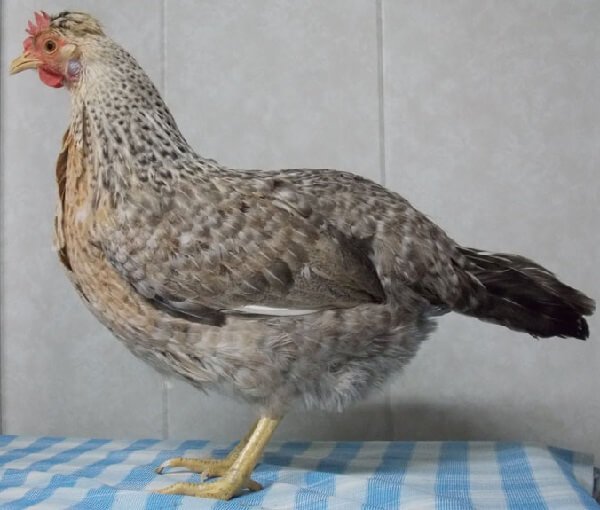
- gold;

- silvery.
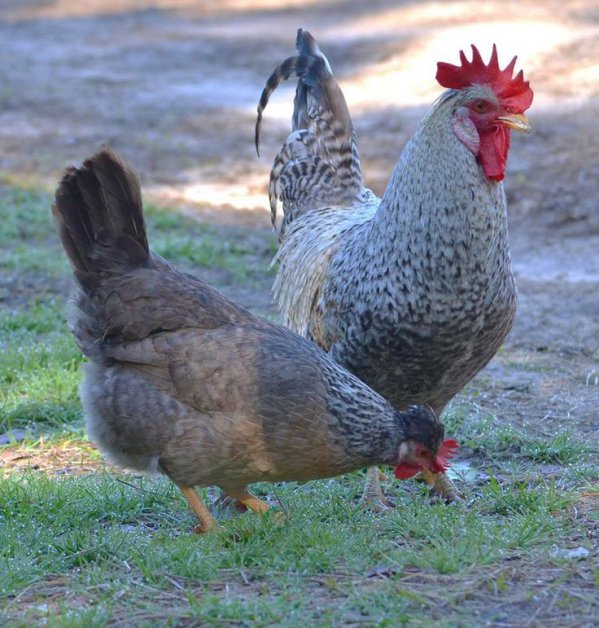
The so-called creamy Legbar chickens are the most common today. The combination of silvery gray and delicate golden shades of plumage creates a common background, set off by bright edging on the feathers. Also, creamy chickens of the Legbar breed have good reviews from the owners.
There is another type of cream Legbar hens - crested chickens. Their description corresponds to the name: a nice creamy color and a tuft.
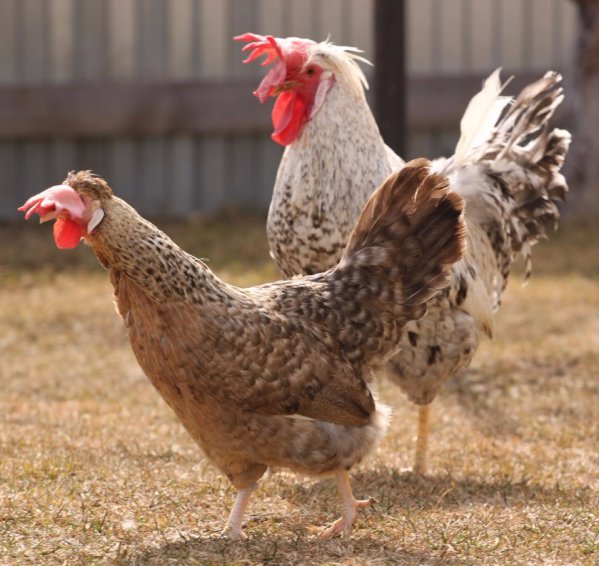
Video: cream-crested Legbar.
Legbar productivity that pleases
Often in the process of bird breeding, it happens that, with an emphasis on external attractiveness, useful characteristics are nullified. But in our case, the beauty of the Legbar birds did not affect the qualities of the chickens.
Characteristics of the productivity of chickens of the Legbar breed:
- They begin to rush from four to five months.
- Laying hens are capable of laying 220-270 eggs per year.
- The egg is rounded (which makes it seem smaller than others), with a strong shell of a bluish or olive shade.
- Each weighs between 60 and 70 g.
When the egg production decreases in cream-colored Legbar chickens, the bird is allowed to eat. Although the carcass is not very massive, it has an excellent presentation, and judging by the reviews of experts, it can be argued that the meat of Legbar chickens is superior in taste to all other breeds.
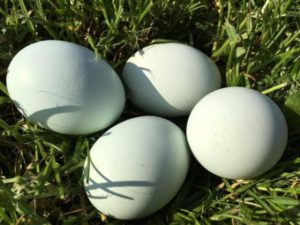
Secrets of the care and maintenance of Legbar chickens
In fact, there are no special secrets, but still there are important points. They should be considered for poultry farming to be successful.
Keeping Legbar chickens requires the following rules:
- With the arrival of warmth and until autumn, the pets are on the walk: they are very mobile and active.
- In winter, they need shelter. Moreover, the chicken coop must meet certain requirements so that its inhabitants feel comfortable and do not get sick:
- The walls of the house need to be dense, without cracks. Drafts are harmful to birds.
- Ventilation will be provided by an ordinary window or exhaust pipes with plugs (to regulate the supply of fresh air and save heat in the cold).
- Birds need enough light. It will be provided by windows, and in winter additional lighting will be needed.

- The room should be clean and warm. The litter should be changed more often, and twice a year, general cleaning and disinfection should be done in the barn.
- Of course, you will need to install perches (from rounded poles, so that each individual has at least 20 cm of space). The best option is to make them in the form of a ladder.
- We must not forget about equipping the "chicken palace" with nests, feeders and drinkers.

Important! Chickens of the Legbar breed drink a lot, twice as much as they eat. Therefore, drinkers should always contain fresh, clean water. In the summer it needs to be changed two or three times, in winter it can be less often.

What to serve on the "table" or diet of Legbar chickens
They say that these chickens are quite capricious creatures and will ignore what the chicken tribe of other breeds bites with pleasure. In order for pets to eat willingly, their food is combined from at least five to six components.
Owners approach livestock feeding in different ways. Whoever has the opportunity to buy food in a specialized store - dry, combined or wet. Others prepare their own meals. And cheaper, and you know exactly what the bird gets.

Appropriate nutrition for Legbar chickens is one of the most important components of proper bird keeping. Over the years, a recipe has been developed that provides all the substances necessary for health and high productivity, including:
- barley;
- corn;
- wheat;
- peas;
- herbal flour;
- fish and meat and bone meal;
- sunflower meal;
- vitamins;
- feed yeast;
- salt.
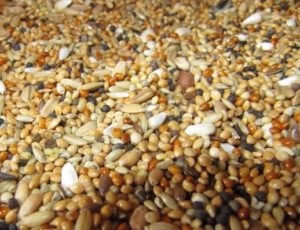
A one-time rate for one bird should be equal to how much it can eat (usually 120 g). It is impossible to overfeed the hens: the overweight chicken will become worse to lay.
Interesting! It is believed that to maintain the bluish tint of the eggs, the bird should be given some kind of special blue food from the store. This is nonsense: the color of the shell is fixed at the genetic level, so no "coloring" additives are needed. But you need to provide the bird with enough calcium. To do this, put dishes with shells, crushed eggshells, limestone or chalk.
Breeding features
Despite the fact that the Legbar chickens run very well, difficulties are possible with the breeding of offspring. One of the features is that females are wonderful layers, but not so good hens, although 9 out of 10 eggs are fertilized.
Important! Chickens of the Legbar breed have difficulties in breeding.
They have almost lost their maternal instinct, and besides, they are extremely restless and active. “Ladies” are simply not able to sit still for a long time in one place. Therefore, novice poultry farmers, in order not to fool around with breeding and caring for chicks, are usually recommended to buy adults. And experienced farmers acquire incubators in which chickens appear.



Video: breeding Legbar chickens
Chicken health
It has already been noted that the representatives of this breed have good immunity to diseases. Yet sometimes they suffer:
- from infectious diseases (colibacillosis, pasteurellosis, salmonellosis, Newcastle disease, smallpox and others);
- non-infectious (gastroenteritis, cloacitis, goiter atony, keratoconjunctivitis and others);
- from defeats by internal and external parasites.
Most often this happens when the requirements for the living conditions of the livestock are violated.
The most basic preventive measure to prevent ailments in Legbar chickens:
- cleanliness in the chicken coop;
- its systematic disinfection;
- vitamins;
- the freshest food and water.

What are the pros and cons of Legbar
The advantages of Legbar chickens are more than disadvantages.
The benefits include:
- high egg production;
- delicious meat;
- good health;
- the ability to eat almost one pasture in the summer;
- beautiful testicles;
- the ability to immediately determine the sex of the chicken.
The disadvantages of this breed of chickens are the need to change the livestock every 2 years due to a decrease in the number of eggs, the lack of maternal instinct in Legbars. That's probably all.
Video: overview and description of cream Legbar chickens
Legbars can become both a decoration of a courtyard due to their striking appearance, and a source of profit, given their high productivity and versatility. Today it is one of the most popular poultry species in the world.

